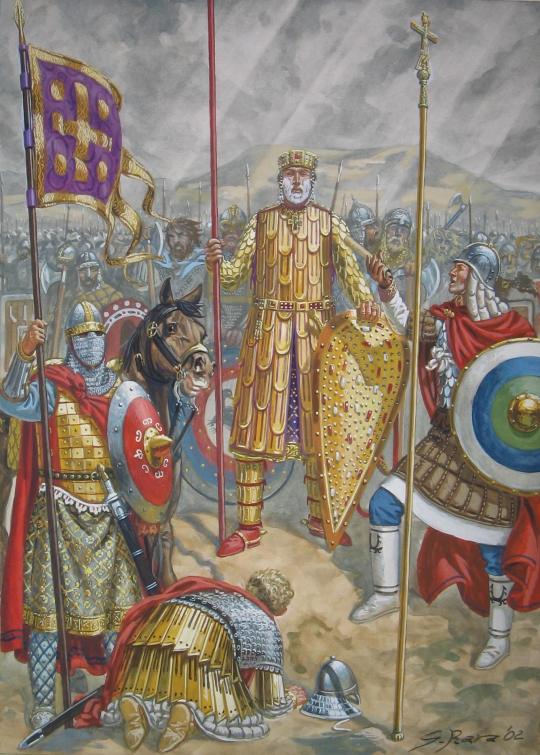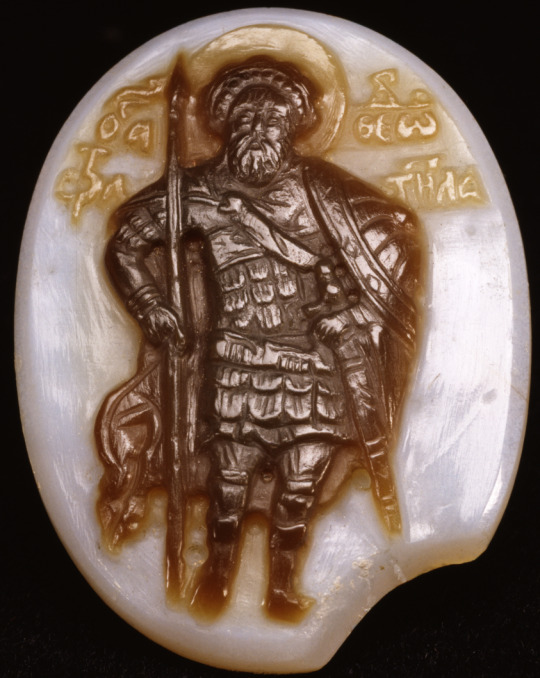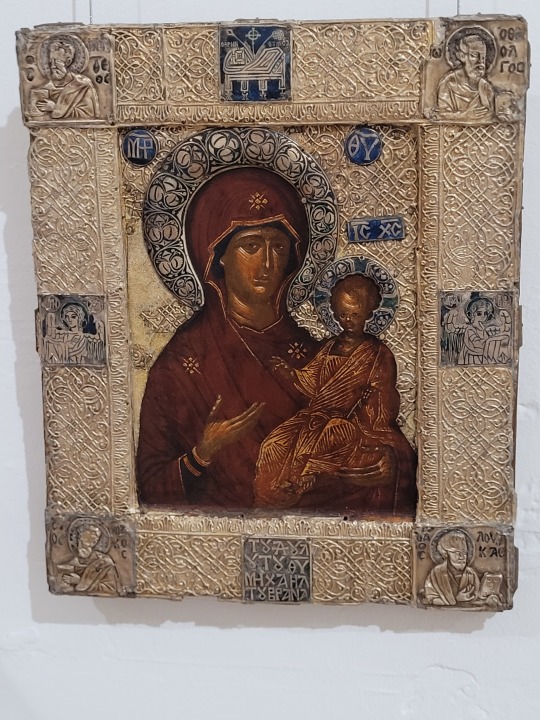#Christian Byzantine Empire
Explore tagged Tumblr posts
Text
Open-access databases of the National Hellenic Research Foundation
The Institute of Historical Research (IHR) of the National Hellenic Research Foundation (NHRF) provides open access to 16 databases concerning Byzantine History and especially Byzantine Greece: https://anavathmis.eu/?lang=en. Based on the scrutiny of a large body of primary and secondary sources by members of the Section of Byzantine Research of the IHR/NHRF and associated scholars, the…
View On WordPress
2 notes
·
View notes
Text

The Emperor of Byzantium Basil II during the Georgian campaign, 1020 by Giuseppe Rava
#giuseppe rava#art#basil ii#bulgar slayer#emperor#byzantium#byzantine#byzantines#byzantine empire#roman#history#middle ages#medieval#varangian#guard#soldiers#georgia#georgian campaign#christianity#christian#cross#christendom#europe#european#asia#empire#varangian guard#romans#standards#banner
206 notes
·
View notes
Text

Sardonyx cameo by an unknown Byzantine artist of the 14th century, depicting St. Theodore Stratelates ("Army Commander"). Theodore (281-319) was a Roman soldier, said to have been martyred during the persecution of Christians by the emperor Licinius. Here, Theodore is shown in full military dress, a spear in his right hand and a round shield on his left shoulder. The accompanying inscription invokes him and his namesake, Theodore "the Recruit," as protectors; the cameo would likely have been suspended from a chain and wore around the neck as a protective amulet.
Now in the Walters Art Museum, Baltimore. Photo credit: Walters Art Museum.
#art#art history#Byzantine#Byzantine Empire#Byzantine art#Byzantium#medieval#medieval art#Middle Ages#Eastern Orthodox#Orthodox Christianity#jewelry#jewellery#cameo#sardonyx#Walters Art Museum
270 notes
·
View notes
Text

Nativity of Christ, Menologion of Basil II, Constantinople, c. 1000.
#byzantine#byzantine history#byzantine art#byzantine empire#greek orthodox#greek orthodox church#christianity#roman#roman art#roman empire#roman history#nativity#miniature painting#illuminated manuscript#medieval#middle ages#medieval history#medieval art
119 notes
·
View notes
Photo




In the Castle City of Mystrás
Mystrás was the capital city of the Despotate of Morea (1262 - 1460), the last Byzantine stronghold against the Franks and the Ottoman Turks. The sons of the Byzantine emperors served in the region as déspotes but in a few occasions the emperors would also be crowned there. Morea eventually fell to the Ottoman Empire seven years after Constantinople (1460). It remained inhabited until 1825 when it was attacked by the Egyptian army under the command of Ibrahim Pasha during the Greek War of Independence. Until then, western explorers often mistook Mystras for Ancient Sparta. In truth, Mystras is overlooking the ruins of Ancient Sparta and the modern city of Sparta is built 8km to the east.
Photos from Wikimedia Commons.
#greece#europe#history#byzantine history#greek history#byzantine empire#byzantine culture#greek culture#christian orthodoxy#architecture#mystras#laconia#peloponnese#peloponnisos#mainland#sparta
110 notes
·
View notes
Text
I find it so weird that people try to deny that queerphobia as it exists in the west is rooted in Christianity. Like, people are literally more focused on not offended the pope than they are protecting queer life.
Remember that there was no queerphobia in the western world before the Christianization of Rome. Caesar being made fun of for being a bottom isn't the same as the queerphobia we see spanning from the late Roman empire to the present day. The first person on earth to outlaw gay male relationships was the byzantine emperor Justinian. The first writing to circulate in the west to talk against homosexuality was the Bible. The systemic cultural and legal marginalization of queer identities is directly tied to Christianity and still is, from Rome, to northern Europe, to Africa (it should be mentioned that the most queerphobic nation on the planet right now had a openly bi king before colonialism) and the Americas, we see that the introduction of queerphobia and the introduction of Christianity are one and the same.
Also when you try to deny that queerphobia comes from Christianity you basically have to claim that people are just naturally queerphobic, which is not only something not back up by history but implies the oppression queer people face is inevitable.
#196#my thougts#leftism#leftist#queer history#queer community#queer rights#queer liberation#paganism#paganblr#pagan#anti christianity#christianity#roman empire#roman history#byzantine#lgbt#lgbtq#lgbtqia#lgbtq community#queer#history#gay#lesbian#bisexuality#bisexual#enby#nonbinary#asexual#transsexual
181 notes
·
View notes
Text

Jesus Christ on a Byzantine Coin.
69 notes
·
View notes
Text




Thalerhof was the first concentration camp in Europe, active from 1914 to 1917 and its primary victims were Eastern Christians. This camp preceded even Dachau which is considered to be the prototype of concentration camps built by Nazi Germany.
It is the place where Austrians interned 30,000 “Russo-philes” which meant that those who identified as Rusyns (or Ruthenian), including Orthodox and Greek Catholics, were interned in either Thalerhof or Terezin.
Rusyns are a little known population who originated in the northern Carpathian mountains, along the modern borders of Poland, Slovakia, and Ukraine. To this day, their identities as Rusyns are not acknowledged and they’re often underrepresented in censuses, especially in Ukraine, where they are merely listed as Ukrainian highlanders.
There are countless efforts to erase this part of Eastern European history and today, Thalerhof has been razed to the ground and an airport is built where it once stood. Carpatho-Rusyns, in their attempt to escape genocide, are responsible for bringing Orthodox Christianity to America.
#eastern europe#austro hungarian empire#orthodox christianity#greek catholics#ruthenians#russophobia#cw death#concentration camp#eastern catholic#byzantine catholic#catholicism#catholic#orthodoxy#eastern orthodoxy#christianity#eastern orthodox#orthodox
68 notes
·
View notes
Text

Missed drawing the Franks
75 notes
·
View notes
Text
New Scientifc Journal: Analekta Stagōn kai Meteōrōn - Analecta Stagorum et Meteororum
Dear Scholars of Byzantium, My colleagues and I would like to bring to your attention the publication of the first issue of Analekta Stagōn kai Meteōrōn – Analecta Stagorum et Meteororum. It is a new biennial scientific journal dedicated to the history and heritage of the monastic community of Meteora, published by the Academy of the Metropolis of Stagoi and Meteora. Its first, celebratory issue…
View On WordPress
0 notes
Text

The Massacre of Antioch by Gustave Doré
#gustave doré#art#antioch#first crusade#crusade#crusades#siege of antioch#history#medieval#middle ages#turkey#christians#muslims#christian#muslim#crusaders#crusader#knights#seljuk empire#byzantine empire#seljuk#byzantine
234 notes
·
View notes
Text

Byzantine icon of the Madonna (Theotokos) and Child, of the type known as Hodegetria (Our Lady of the Way): Mary gestures toward the infant Christ, who in turn raises his hand in a sign of blessing. The type originated in a now lost icon from the Monastery of the Panagia Hodegetria in Constantinople that was said to have been painted by St. Luke. This example, by an unknown artist, dates to the 14th century and is in the MUZA, Valletta, Malta.
#art#art history#Middle Ages#medieval#medieval art#Byzantine#Byzantine Empire#Byzantine art#icon#iconography#religious art#Christian art#Christianity#Orthodox Christianity#Eastern Orthodox#Madonna and Child#Theotokos#Hodegetria#14th century art#MUZA
198 notes
·
View notes
Text

Icon of the Virgin Hodegetria, by an Italian artist active in Cyprus, 1210. Byzantine and Christian Museum in Athens, Greece.
#byzantine#byzantine history#byzantine empire#roman art#roman history#roman empire#greek orthodox#greek orthodox church#christian#christianity#medieva art#medieval history#middle ages#christian art#icon#medieval
14 notes
·
View notes
Note
Any tasty Tsiknopempti lore you could share with us? :P
This came after Tsiknopempti was over so it caught me off guard!
Tbh not much I can say but I can tell you why this day exists, which even some Greeks might not know. In fact I will make a Greek Carnival meaning post:
Απόκριες (apókries, Greek Carnival)
Tsiknopempti (Grilled Meat Smoke Thursday) was the Thursday that just passed.
It is the most famous day of the second week of Carnival.
Carnival celebrations in Greece last three weeks. The Greek word for Carnival is Αποκριά (Apokriá) or Απόκριες (Apókries) which means “(abstaining) from meat”. In fact, the English word has a similar Latin etymology (carne-vale). The Carnival celebrations herald the last weeks of allowed “debauchery” before the Great Lent, the most important and strict Greek Orthdox fast.
So, each week of the Apokries symbolises a different thing.
The first week is called Προφωνή (Prophoní) which more or less means “the Herald”. It is the introductory week to the carnival celebrations and in the past they used to send heralds to announce the opening of the carnival celebrations so families could organise their supplies for the festivities. In Byzantine times, the heralds would urge everyone to participate in the festivities even beyond their means “I herald to you, poor man, sell your coat, and partake in the celebration”. In Naxos island, in more recent times, the Byzantine heralding turned even more hardcore “I herald to you, poor man, and if you cannot buy, then steal!”. On this first week, it was also believed that the souls of the dead were released on the world of the living.
The second week is the Κρεατινή (Kreatiní) which means the “Meat Week” or Κρεοφάγος (kreophághos), “Meat Eating Week”. This is the week you are free to eat so much meat in order to make up for all the next weeks that you supposedly won’t due to the Great Lent. This is also the only week of the year that you can eat meat even on a Wednesday and a Friday (nowadays only applies to very pious Christians). The most famous day of the week is the Tsiknopempti (Grilled meat smoke Thursday) when it is tradition to eat grilled meats. The reason this Thursday is special is because it is the eleventh day of Carnival and Carnival lasts 22 days so it is exactly in the middle of the festivities. Therefore the meat eating is at its peak.

The Sunday of the Kreatiní week is called Κυριακή της Απόκρεω (Kyriakí tis Apókreo) which means “Carnival Sunday” but as we saw it technically means “Abstaining from Meat Sunday”. That’s because it is the last day of meat eating.
The third and last week of Carnival is called Τυρινή (tyriní) meaning “Cheese Week” or Τυροφάγος (tyrophághos) meaning “Cheese eating Week). It is nowadays the peak weak of carnival celebrations although traditionally it was supposed to be a mediator between the previous Carnival “debauchery” and the Great Lent, serving as a gradual preparation for the long fast. So during the Tyrophagos traditionally you can still eat animal based products like dairy and seafood but you can not eat red and white meat anymore. During this week people also eat pasta. The last day of the weak Κυριακή της Τυροφάγου (Kyriakí tis Tyrophághu), Sunday of the Cheese Eater, is the last and peak day of Carnival.
The next day is Καθαρά Δευτέρα (Kathará Ðeftéra), the Clean Monday or Ash Monday as it is known in other cultures, the purifying first day of the Great Lent.
I only recently learned what each of these days / weeks stood for so I thought it would be interesting to write about it!
#greece#carnival#tradition#Greek orthodoxy#Christianity#Greek culture#great lent#Tsiknopempti#apokries#anon#ask#Byzantine empire#Byzantine culture#Byzantine history
41 notes
·
View notes
Text
Does anyone know if there were any ancient connections between Hermes/Mercury and Jesus?
I know when Christianity was gaining popularity in ancient Rome, conflating Zeus/Jupiter and Jesus was popular because they’re both kings of Heaven and it was easy to explain this new god to people who had only known the Roman pantheon. And there were lots of sculptures and drawings of Jesus and other Christian religious figures modeled after Roman Emperor equestrian portraits because it showed power and leadership.
But to me it would make sense to combine Hermes/Mercury and Jesus.
Both are messengers for their heavenly, king of Heaven dad. Both spend a lot of time with mortals and assist in daily life. Both assure souls to the afterlife (although in different ways). Both have connections/epithets about shepherding (tho Hermes’ is more literal). This was more in the Middle Ages rather than Christian Rome, but they both have ties with intersex bodies. (A part of European alchemy was intersex Jesus and Hermes’ kid was Hermaphrodite.) I’m sure there are other things I can’t think of at the moment.
Does anyone know if there was a connection either visually or culturally between them?
#history#art history#christianity#archeology#Jesus#hermes#Mercury#ancient rome#I’m also going to tag#Ancient Greece#Byzantium#Byzantine empire#early Christianity#jesus christ
17 notes
·
View notes
Text

Mosaic of Jesus in the Pammakaristos Church in Istanbul or Constantinople.
#byzantine#eastern roman empire#roman empire#christians#history#christianity#jesus#jesus christ#constantinople#virgin mary#catholicism#eastern orthodoxy#holy spirit#byzantine art#art
27 notes
·
View notes